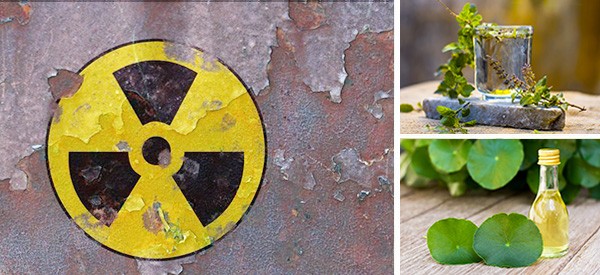
How To Protect Yourself Against Radiation With These 5 Herbs
There have been hundreds of years of intense research conducted into the possible radioprotective qualities of botanicals, including plants, foods, and herbs.
Many studies have shown that a majority of the botanical world comprises at least one element that can assist in the healing process within the human body, including skin complaints and organ function.
Much of the studies date back to evidence that was proclaimed as healing substances from our ancestors all around the world, at a time when modern-day medicine was not as advanced as it is today. The natural world products were the only elements they had available to investigate their healing properties.
Ancient healing solutions that were heavily based around botanicals have since been studied and developed to apply factual truth to the widely used methods of healing of years gone by.
While we heavily rely on modern medicine to heal the person today, a majority, if not all of the medicines and treatments provided are chemical and synthetically based; although some treatments are vital to preserving life, we need to find more natural ways to heal the body, including the effects from radiation.
What Is Radiation?
A simple way to understand radiation is that it is energy emitted from an originating source or action that comes in the form of waves or particles, such as a candle that emits light and heat.
As you can see clearly from this example, not all variations of radiation are harmful. However, there are types of radiation that can be extremely harmful with exposure, both in the short and long term, such as Gamma Rays, which are otherwise known as Ionizing Radioactive Rays.
Ionizing Radiation is especially harmful to the DNA structures of the human body. They can change and cause dangerous deformations of the DNA make-Up, which can cause incredibly damaging changes to the body’s DNA sequencing.
It is essential to protect ourselves against potentially harmful radiation on a daily basis, as radiation is something we simply cannot see and the instances of being exposed to harmful radiation are ever-increasing.
Protection against permanent radiation damage can be sought naturally, with many botanical elements providing some super health benefits. Still, here we will be looking specifically at the best herbs to protect against the harmful effects of radiation.
Which 5 Herbs Are The Best For Protection?
1. Gale Of The Wind (Phyllanthus Amarus)
Phyllanthus Amarus is a leafy herbal plant that is often found growing in areas of North America that are more tropical than the rest of the region.
This herbal plant is easy to identify with neatly arranged oval leaves and berries below the offshoot stalk. From above, it almost looks like the structure of a sider web splaying out from the center.
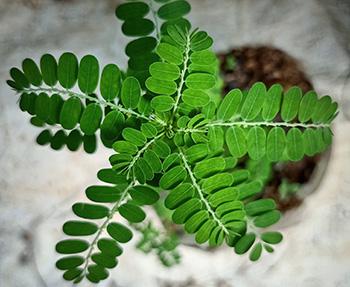 This plant is still used incredibly widely in natural health supplements worldwide, especially ones that are used for easing digestive complaints, Kidney protection, and healing, as well as being a great Radioactivity protector.
This plant is still used incredibly widely in natural health supplements worldwide, especially ones that are used for easing digestive complaints, Kidney protection, and healing, as well as being a great Radioactivity protector.
How to use it: It has an incredibly bitter taste, so it is best prepared with some sweeter elements to make it more palatable (unless you like the bitter edge!).
It is possible to use the whole of the plant for preparation, including the leaves, stem, and root, and can be used to make teas for consumption or tinctures for external topical healing actions.
Top Tip: This herb is bitter, so it can be made more palatable by steeping in hot water with a touch of natural honey to counteract the astringent flavor and consumed warm with your favorite mug.
2. Holy Basil (Ocimum Sanctum)
Commonly called Holy Basil or Sacred basil, this is one of India’s most widely grown and used plants but can also be found in the wild in temperate climates or produced domestically as decorative and medicinal home plants.
The plant is incredibly distinctive by its hairy stems with medium-sized leaves that are soft in texture and slightly jagged around the edges.
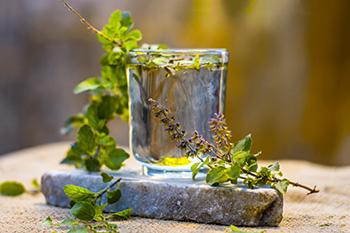 How to use it: These leaves, roots, and shoots can all be used to prepare protective teas by steeping them in hot water and allowing them to infuse. However, the leaves of the Holy Basil are widely used in cooking and can be added to soups, stews and used as garnishes on many, many dishes.
How to use it: These leaves, roots, and shoots can all be used to prepare protective teas by steeping them in hot water and allowing them to infuse. However, the leaves of the Holy Basil are widely used in cooking and can be added to soups, stews and used as garnishes on many, many dishes.
Many studies of this herb have shown that the medicinal qualities are plentiful, including skin complaints, anti-aging properties, and an excellent Radioactive protector as it contains many water-soluble flavonoids.
Basil is so versatile in all areas of cooking, but it’s best not to overheat and lose some of its potency. Instead, add to wholewheat pasta just at the end of cooking with some cream cheese.
3. Indian Pennywort (Centella Asiatica)
Part of the parsley family, Centella Asiatica is a native to Asia as a perennial herb and is said to be a membrane protector against DNA damage caused by radiation. It is a herb that is full of phytochemicals and cell-repairing amino acids.
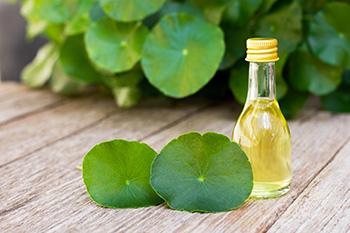 This herb grows in appearance much like watercress on long, soft stalks, and the foliage looks like a penny balanced on the top, hence the name! It has the deepest green color, which is an indicator of the amount of chlorophyll that is contained within it.
This herb grows in appearance much like watercress on long, soft stalks, and the foliage looks like a penny balanced on the top, hence the name! It has the deepest green color, which is an indicator of the amount of chlorophyll that is contained within it.
How to use it: Centella Asiatica is widely used in oriental natural medicines in dry and capsule formulae. However, you can take the fresh leaves and stalks from this beautiful herb and steep them in hot water for tea. They can also be freshly frozen for preservation and used in pesto or herb salads.
When it is freshly picked, preserve in a little natural oil, and when you are ready for pesto, add the other ingredients and whizz up for a delicious super-herb pesto-style dressing.
4. Mint (Mentha Arvensis)
Mint is one of the most commonly available and versatile herbs grown and recognized all around the world. It can easily be found growing wild in many areas of the world and can also be grown in bulk for commercial consumption.
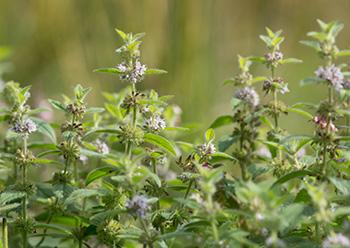 The two specific varieties of mint called Mentha Arvensis and M. Piperita are the varieties with most of the natural goodness we require to protect against radiation, specifically associated with the easing of sickness caused by radiation exposure and radiation mortality.
The two specific varieties of mint called Mentha Arvensis and M. Piperita are the varieties with most of the natural goodness we require to protect against radiation, specifically associated with the easing of sickness caused by radiation exposure and radiation mortality.
Mint is very distinctive due to the leaves having the most amazing minty smell when rubbed between 2 fingers, and the leaves of the plant are slightly furry in texture, with small leaves that are somewhat jagged around the edges.
How to use it: The preparation of these can be incredibly easy and can be added to pesto, hot water and lemon, salads, and summer drinks.
Adding mint leaves to boiled and cooled water and allow to infuse, add a squeeze of lemon, and cool in the fridge. Upon serving, add a dash of sparkling water for a refreshing and protective summer drink.
5. Cilantro (Coriandrum Sativum)
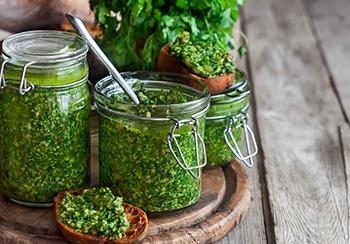 Cilantro is an incredibly common herb used in the culinary world and tastes slightly citrus-like. You can find it growing in the wild, but again, it can also be produced domestically or for mass consumption.
Cilantro is an incredibly common herb used in the culinary world and tastes slightly citrus-like. You can find it growing in the wild, but again, it can also be produced domestically or for mass consumption.
Cilantro is native to Southern Europe, Northern Africa, to Southwestern Asia, and both leaves and stems can be used in all manner of ways, from vinaigrettes, garnishes, and steeped teas.
In regards to Cilantro being a protective element against radiation, it has been scientifically recognized to move radioactive material out of the cell membranes and into the body’s own detoxification avenues.
How to use it: Add Cilantro to any garden salad for a citrus flavor, or add to natural oil and allow to infuse for an all-round protective dressing.
Conclusion
Radiation can take so many formats, and as the sources of radiation get more common in everyday life, we need to find more natural ways to combat the effects of radiation and protect ourselves from potential harm.
Nature has so many solutions to so many of life’s health issues. In this instance, herbs can be the concentrated super-protectors you need to protect yourself from the effects of everyday radiation and even more intense sources of radiation.
While all of the herbs mentioned here have their benefits written for consumption, you can also use many of these herbs for the protection of radiation externally. Tinctures, additional ingredients in natural skincare, and all the beautiful foods you can make with the super herbs.
You may also like:
How to Make a Natural Sunscreen
Are Your Migraines Hiding Something More Serious? (Video)
Best Herbs for Lungs and Respiratory Support

Thank you
Hi Kimberly,
Thank you for taking the time to read our articles.
Many blessings and good health!
I want to know what’s good for nail fungus
Very informative. Something I had not thought about.
Hi Paula,
Thank you for your comment.
We are glad to hear that you found this helpful and informative.
Many blessings and good health!
Didnt the succulent commonly known as ‘Hens and chicks’ also get studied for a natural remedy for radiation sickness or radiation burns?
Hi Grama + Pei,
Thank you for reminding us about the house plants.
Houseplants have properties that can also be very helpful in absorbing radiation and reducing your electromagnetic exposure by taking on that burden themselves.
So keeping an indoor plant (or outdoor plant) that can absorb radiation is a good idea.
A cactus plant or succulents are hardy plants that thrive in almost any environment. Researchers at NASA discovered that these plants are great for absorbing certain types of EMF radiation.
Many blessings and good health!
Wow! Never knew this. Can you suggest which types of cactus to get for emf protection?
Very good stuff, thank you
Hi William,
Thank you for trusting us.
Many blessings and good health!
I saw that Cilantro is also good for chelating out toxins. I guess I should learn to like Cilantro and incorporate it and maybe I should grow a box of mint on my window sill.
In Mexico, they eat cilantro all the time. In the higher altitudes, greenhouses everywhere growing cilantro.
I use herbs and learning more everyday how to use them
Hi Iva,
We are glad to hear that 🙂
There’s always something new to learn for all of us and nature and life in general, never stops teaching.
Many blessings and good health!
Thank you for this – good to know!
Hi Jo,
Thank you for your continued support.
Glad to hear you liked the article.
Many blessings and good health!
I wonder if any kind of mint is helpful. We have water mint growing wild here.
Hi Mary,
Studies in the recent past have shown that some medicinal plants possess radioprotective effects. And Mint is one of them, possessing significant radioprotective properties.
Many blessings and good health!
Thanks so much for this!!! My daughter is studying the effects of radiation / detection and how it affects plants. Etc. If you have any more information she can glean from please let me know so I can share with her. Any resource would be so appreciated. Thanks again.
I was diagnosed with stage 1 breast cancer. I will be having surgery and then radiation. Are these herbs safe to take during radiation treatment?
Did you know that you now have the option of having the surgery withOUT the radiation? It is much safer and less chance of the breast cancer recurring later. However, as with all surgeries, having a strong immune system before, during, and after involves consuming all the right hebal foods. Been there. Prayers for you. 🙂
I am learning more and more about herbs and how to use them. Thank you for sharing.
The late Dr. Akizuki, a medical doctor in Nagasaki at the time of the atomic bombing in 1945, survived and served to help the injured. He observed that these survivors of the atomic blast had a common diet practice, which was a traditional Japanese diet enriched with Miso seaweed soup. Dr. Akizuki unfortunately passed away in 2005, but I was able to interview Mrs. Akizuki, as well as other atomic bomb survivors, a total of 30 people, in Hiroshima and Nagasaki. https://www.yufoundation.org/pdfs/furo.pdf